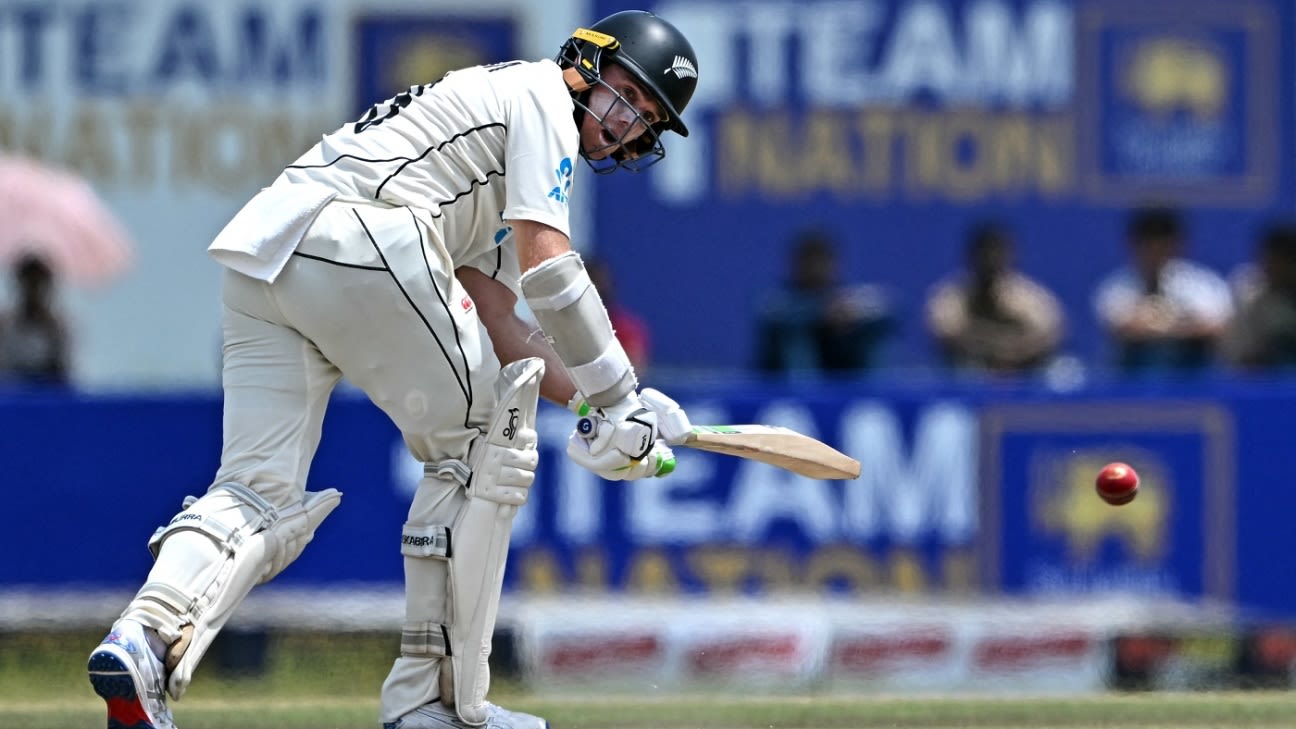Latham’s sweeping success shows NZ will not get bogged down on turning tracks

For Latham, this was a stress-free checked square drive for two. It clearly wasn’t tentative. But it wasn’t an eye-catching statement of intent either. It was assured, run-seeking batting.
His judgement of length was brisk. His feet moved fluently enough to take him back into the crease. He timed it nicely, without hitting the leather off it. This is where good batting against spin lives. New Zealand’s top order batted like a team that knows all that.
We’re about to get deep into batting-nerd territory here, but you really can’t do justice to the big picture unless you hone in on the molecular. We’ll stick with Latham for a bit, since he played day two’s most substantial innings. In the 15th over, he missed a sweep against Ramesh Mendis, generally Sri Lanka’s biggest turner of the ball. He missed it because he had played over the ball and rolled his wrists. Of all the ways to miss a sweep, this is the safest – even if you under-edge it, it would hit the pitch straightaway, or thud into the wicketkeeper’s boot. You’d have to be quite unlucky to drag it onto the stumps.
You’ve missed that ball, but don’t sweat it. You can’t stress not sweating it enough. On turning tracks, balls will be missed. But the job is to make runs. No one cares if you miss the fewest balls.
Latham, at this stage in his career, is a proficient player of spin. So next ball, Ramesh bowls a similar line, and Latham sweeps again, this time over-correcting, and getting the bat under the ball a little. It goes off the top half of the bat, but because he’s only paddled it, it loops off into vacant space around short fine leg, and Latham gets two. Fifth ball, he gets a ball that pitches on around middle and leg, and this time Latham is all over it, sweeping it fine, along the ground, for four.
The first failed sweep did not stop him from playing a second imperfect sweep, which in turn did not stop him from sweeping a bad ball for four. Latham’s playing of spin is partly built around his being able to play variations of conventional sweep nicely. But other New Zealand batters have their own ways of countering spin.
Where in previous decades, teams from SENA (South Africa, England, New Zealand and Australia) were often caught in horrendous, traumatic cycles of spin-playing ineptitude, and in response issued team diktats such as “be more aggressive”, “sweep more often”, “come down the pitch more” etc… the approach has more recently shifted. Now it’s about equipping batters with a wider repertoire of shots, encouraging them to either go back or come forward and not get caught in between, encouraging them to seek the run-scoring opportunities, but vitally, having them find their own way.
We have T20s to thank for fitting batters with a space-age arsenal of strokes, of course. But then the likes of Latham, who is not a white-ball star the way Mitchell is these days, have also found success. Looking for runs is key, he said.
“My plan in these conditions is to be proactive and to use the sweep shot as I’m sure you saw… That’s my mode in terms of how I operate in these conditions”
Tom Latham
“In this part of the world, when you’re facing a lot of balls, when you can’t get off strike, it does become harder,” Latham said. He was caught in the deep sweeping in what would have been the last over before tea.
He’s got to have regrets about that, right? “No, not really. My plan in these conditions is to be proactive and to use the sweep shot as I’m sure you saw. Other days it doesn’t go to the fielder on the boundary. Today it didn’t work out. But that’s my mode in terms of how I operate in these conditions.” It’s hard to argue with a guy whose score of 70 on Thursday actually brought his average in the country down a touch.
Other SENA sides – England and Australia especially – have also raised their games significantly in an era in which big-turning pitches have been normalised in places like Sri Lanka and India.
For New Zealand, getting to 255 for 4 at Galle was especially meaningful. This was their first Test in a five-match sequence in what is likely to be big-turning conditions – one more match in Galle, then games in Bengaluru, Pune and Mumbai to follow.
On their first day of batting on this long South Asia tour, they’ve suggested they will do much better than has often been expected – that they are not going to crumble meekly against spin.
Andrew Fidel Fernando is a senior writer at ESPNcricinfo. @afidelf
Related
‘Listen from one ear, ignore from the other’: Former India…
India's Rohit Sharma and Mohammed Shami (AP Photo) NEW DELHI: Former wicketkeeper-batter Syed Kirmani has expressed his opinion that experienced fast bowler Mo
India faces New Zealand in budding rivalry at Champions Trophy…
State AlabamaAlaskaArizonaArkansasCa
ICC and Unilever announce landmark partnership on International Women’s Day…
The two-year partnership, kicking off at this year’s Women’s Cricket World Cup in India and running until the end of 2027, marks the world cricket governing
IPL 2025: Mumbai Indians sign Corbin Bosch as replacement for…
Mumbai Indians have signed South Africa all-rounder Corbin Bosch as a replacement for his injured countryman Lizaad Williams for this year's Indian Premier Leag











